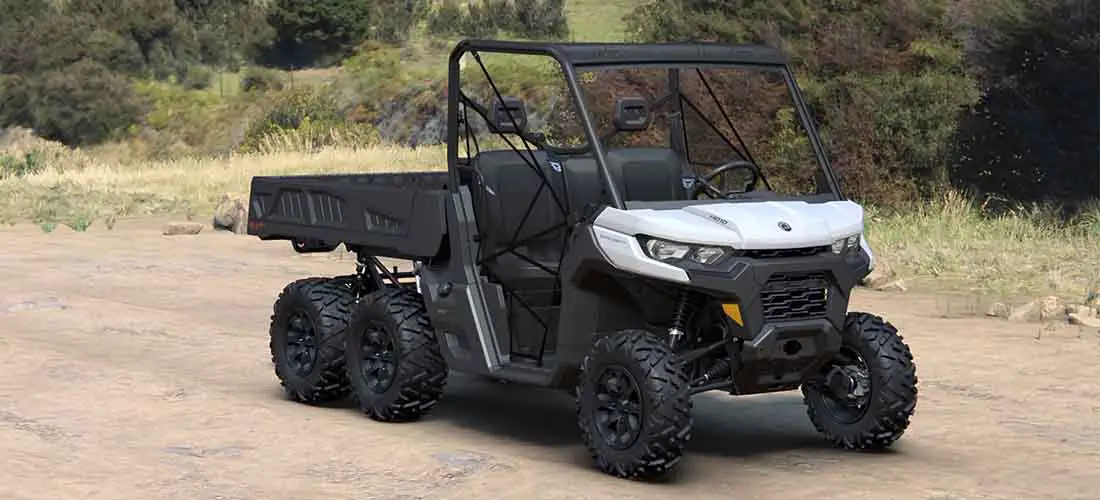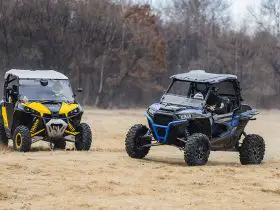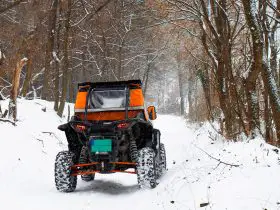For long six wheels could only be seen on military or special purpose vehicles. Slowly, a 6×6 drive started to appear on pickup trucks and SUVs. Now there numerous vehicles off all types featuring six-wheel drive and UTV’s are no exception in joining this trend.
Table of Contents
What is a 6×6 UTV?
The six-wheel-drive is the next evolutionary step in the development of these UTVs. As side-by-sides have always been the vehicles mainly intended for recreational and commercial off-road purposes, it’s only normal that users want the exact thing that six-wheelers bring – more traction and more load handling ability. 6×6 UTVs, as their name says, have six wheels that are usually deployed on one forward and two rear axles.
Side-by-sides with three evenly spaced axles are practically non-existent. 6-wheel off-roaders were designed with the roughest terrain and toughest assignments on the mind. 6×6 drive is making them capable of handling the worst trail conditions. Also, their increased length and stability mean that they can carry the extremely heavy and robust load, making them especially useful for farmers, woodworkers, or on construction sites and surface mines.
Their ability to carry a significant load while being able to reach otherwise unapproachable areas make them a very useful vehicle for various public services. Many fire departments and emergency wards already use customized 6×6 UTVs.
The best 6×6 UTVs
Not all of the prominent UTV manufacturers have a 6×6 model in their line-up. The 6×6 drive is still a novelty in the UTV world. The demand for them is increasing and we will certainly see more of them.
The fact is that some of the major companies are yet to come out with models with six wheels. Especially Japanese and European factories, such as Yamaha, Honda, Kawasaki, or Husqvarna are lagging behind.
Still, there are some well-made and powerful vehicles to choose from. Some of them are modifications of the existing four-wheel versions. We’ll take a closer look at the ones we consider to be the top in this class.
Can-Am Defender 6×6 DPS
Based on the legendary 4×4 version of the Defender, Can-Am’s 6×6 vehicle gives you all the strength and traction you may want, while being surprisingly nimble, easy to handle, and comfortable for one of the largest UTVs.
Although based on it, 6×6 Defender is not just a four-wheeler with the extra axle added. The vehicle was given a complete makeover to make it easier to ride and add to durability. Part of the new look is the double-arched A-arms on the front axle with 11 inches of travel and a suspension sway bar at the back which adds to the stability.
It deals with the roughest trails without too much trouble satisfying the requirements of even the most demanding riders. At the same time, its load capacity and power make it a perfect workhorse for commercial use.
The third axle is responsible for excellent stability, even on the very uneven ground, and the traction way beyond what you can get with a four-wheeler. The extra axle enables the vehicle to have more frequent contact with the ground which provides a smoother ride.
The turn radius is the main issue people have with the 6×6 side-by-sides. Still, the Defender manages to minimize this issue and is capable of making rather tight turns, at least for the tree-axled vehicle of this size. It may not be as elegant and precise while turning as its 4×4 counterparts, but the sheer power of its HD10 82hp engine more than makes up for it.
Anyways, if you use it for work on the ranch or a farm, most of your driving will at slow speeds while carrying a heavy load or pulling a trailer. This is where the torque of 69 lbs-ft comes more than handy. Depending on your needs, you can select the four or six-wheel drive.
There are three driving modes to choose from: ECO – limiting torque and high speed, ECO off – unlimited “normal” ride, and WORK – for situations when you’re handling a particularly heavy load. The Defender 6×6 is unexpectedly agile and snappy on the first throttle getting even better at the mid-range.
6×6 Defender can tow up to 3000 lbs (an 500 lbs upgrade from the previous version) and has a cargo capacity of 1000 lbs, aided by a tailgate maximum load of 250 lbs. One of the main advantages of the 6×6 machine is a large cargo bed and this one is no different. At 6 feet of length, it almost doubles what you can get with similar vehicles.
The cargo bed has removable sides, so you can make it flat in case you have to transport a load that exceeds its dimensions. there are several attachment points for securing this kind of load. The best thing is that you can hardly feel all of this load while driving.
The cabin in this Defender is a three-seater, due to the space occupied by the cargo bed. Still, it’s very comfortable and equipped with VERSA-PRO seats, guaranteeing a ride as smooth as possible for a utility vehicle. Plenty of space and legroom also make tall people feel comfortable. Inside the cabin, there are all the usual accessories we are used to seeing with Can-Am. 4.5-inch display, tachometer, odometer, speedometer, hour, and trip meters, and there’s also an option of installing the additional accessories. The steering wheel is adjustable so the driver can get into a good position, but, unfortunately, this Defender has no adjustable seats. The cabin also features several additional storage spaces. Also, if you are not using the extra seats, you can simply flip them to get even more capacity. The engine is paced right behind the cabin, so it might get a little bit louder than you may have been used to with 4×4 UTVs.
Find out more at the Can-Am Defender website.
Specs
- HD10 82 hp 976 cc V-twin engine
- PRO-TORQ transmission
- 4WD/6WD selectable drive
- Dynamic Power Steering (DPS)
- Maxxis Bighorn 2.0 tires, 27×9-14 at the front, 27×11-14 at the rear
- Overall dimensions: 153.4x64x78 inches
- 1994.5 lbs dry weight
- 155.5 in wheelbase
- 1000+250 lbs cargo bed capacity
- 3000 lbs towing capacity
- 1700 lbs payload capacity
- $17.999 MSRP
Polaris Ranger 6×6
Can-Am’s biggest competitor on the US market, Polaris, also boasts a high- quality heavy-duty 6×6 model. Ranger 6×6 is mainly geared towards contractors, farmers, municipalities, and emergency services, but due to its fantastic ability to handle almost any terrain, ith has found admirers among outdoorsmen and adventures. Quick, powerful, and mobile, it’s more than ready for any challenges you may put in front of it.
The Ranger 6×6 features CVT transmission with ah six-wheel shift drive. Electronic monitoring of all three pairs of wheels enables seamless power transfer between the front and the rear in case that any of the sets loses traction. This enables the UTV to move forward, even if all of the 4 rear wheels are slipping. In case you find yourself in very muddy or snowy conditions, the traction system will let the wheels slip more so they can sort of propel out that kind of situation. The Ranger’s system makes it really difficult to get stuck in the mud or snow, mean extremely useful feature if we know that a lot of its use is in those exact conditions.
Longer A-arms and greater wheel travel, made possible by longer chassis, make sure that the ride is comfortable as it can be, even on the rocky and uneven terrain. At the rear, the independent suspension makes it possible for each wheel to articulate separately, providing maximum traction and ground contact. Anti-kickback steering allows for one-hand steering and significantly reduces the wheel feedback you may feel when going over the bumps.
The Ranger’s cargo bed is a bit smaller than the one found on the Defender, but still at 54 inches width is more than enough for a normal shipping palette and can also be extended by lowering the tailgate. 15 cubic feet of cargo volume and 1250 lbs load capacity should do for most of your needs. The great thing, rarely seen at other similar vehicles, is that you can release the box for dumping on both sides of the vehicle.
The 6×6 Ranger, at first glance, looks rugged and robust, exuberating the strength beneath the hood. The armored front gives the vehicle sort of military look and protects the most vital and vulnerable components even during the roughest rides on the nastiest terrain. The extended chassis, besides more space for cargo, offers extra legroom in the cabin and more comfortability.
It has, also, enabled the placement of a truck-like toolbox between the cargo bed and the back of the seat. A large bench easily seats three people and is very easy on the body during longer rides. Under the seats, there are an extra 20 gallons of storage space. The dashboard includes a multifunctional panel, a cup holder, and a conveniently placed parking brake lever.
Find out more at ranger.polaris.com.
Specs
- 760ccs 4-stroke 40 hp Twin-cylinder engine
- Automatic PVT transmission
- Polaris On-demand True 6WD/4WD drive
- 25×10-12 front tires, 25×11-12 rear tires
- 137x60x76 inches overall dimensions
- 42.5x54x11 inches bed box
- 1250 lbs bed capacity
- 1551 lbs dry weight
- 1750 lbs payload capacity
- 12 inches ground clearance
- 2000 lbs towing capacity
- $12.599 MSRP
John Deere Gator TH Diesel
A long-time favorite among the US farmers, John Deere Gator 6×4 is a heavy-duty workhorse, with a diesel engine guaranteeing toughness and durability. Gator is more than prepared for anything you may throw at it and can withstand the touches work conditions without a hitch. Unlike the TVs we mentioned above, this vehicle features only a four-wheel-drive system, although it also has 6 wheels. The power from the engine is transmitted to the transaxle and further to the center axle. The rear axle is connected to the center axle and driven by a chain system connected on both sides. Roller chains are exposed and do require regular maintenance and cleaning. However, changing gears is very smooth and operated with the lever placed between the seats.
Gator 6×4 is powered by an 18.5 hp engine from Japanese manufacturer Yanmar. It provides more than enough power to smoothly run up the steep hills under the full load. Due to the absence of the roof and sidebars, Gator is significantly lighter than its Can-Am and Polaris relatives and the somewhat weaker engine handles its weight easily. High torque level makes all the difference. This UTV’s engine runs on diesel which is particularly convenient for farmers since most of the other agricultural machines use diesel too.
Since it’s a bit smaller than other six-wheel UTVs, the 6×4 gator does much better in the corners, It has a tight turning circle and coming up a particularly sharp corner you won’t feel much different then if you were driving a four-wheeled side-by-side. It sometimes oversteers around corners in wet conditions since the rear four wheels tent to push the whole vehicle toward a straight line.
The lower height of the Gator is very convenient when it comes to loading and unloading. Also, the tailgate can be lowered by 150 degrees making it even easier. The sides and tailgate of the spacious cargo bed are made of 15-percent polypropylene material that eliminates rust and makes maintenance no problem. 14 tie-down points make sure that your load is safe and secure at all times, even on bumpy terrain.
John Deere Gator 6×4 knows exactly what it is. An amazing vehicle for all of the daily chores at the farm or lumberyard. Hence the lower top speed of around 20 mph. This is not a UTV for acing or extreme trail riding, which doesn’t necessarily mean that it can’t be used for occasional recreational trail riding. Gator 6×4 is also available with the Kawasaki gs engine.
Find out more at the John Deere website.
Specs
- 18.5 hp 993 cc 3-cylinder engine
- 4WD drive
- CVT transmission
- 107x60x44 inches overall dimensions
- 45x12x52 inches cargo bed
- 1200 lbs cargo bed capacity
- 1400 lbs towing capacity
- 6.5 inches ground clearance
- 5 gallons of fuel capacity
- 1200 lbs weight
- $13.449 MSRP
When do you need a six-wheel UTV?
As we all know, riding a UTV in adverse weather and terrain conditions is half of the fun. In addition, people using side-by-sides for work, like farmers, construction workers, or woodworkers really don’t have much say in what’s the weather gonna be like on any given day. And the work needs to be done and completed. The better traction provided by 6×6 UTVs provides more ground contact, prevents slippage, and makes it easier to get out of sticky situations when you find yourself stuck in the mud or snow. Furthermore, six wheels provide better overall weight distributions and leave a shallower track behind them. This is important when you have to drive over the grass or land and preserves your estate in better condition. On the other hand, more traction means more wear and tear for the tires, so make sure that you get a quality set if you plan on owning a 6×6 UTV.
Another important reason that may sway you in the direction of 6-wheeled side-by-side is larger load capacity. For many who use these vehicles for work, this may be the deciding factor. The 6-wheelers can handle more cargo than similar vehicles both in terms of weight and size. For example, Can-Am Defender 6×6 has almost twice a longer cargo bed than its 4×4 counterpart and can carry 1250 lbs compared to the 600 lbs for the regular Defender with HD5 engine. If you’re hauling wood, construction material, or various equipment every pond and inch can matter. You can even load an ATV or another smaller UTV onto the 6-wheeler’s cargo bed.
Six-wheel vs four-wheel UTVs
As we already mentioned, 6-wheeled UTV has some clear advantages over the 4-wheeled ones. Nevertheless, there are some drawbacks to owning a 6×6 side-by-side. We’ll go through some of the factors that can help you decide which one is the right one for you.
Price
The production costs of a 6×6 are logically higher than the cost of making a 4×4, so it’s normal that 6-wheelers are more expensive. Another factor that adds to the price of UTVs with six wheels is that they are not yet in very high demand so they are produced in much smaller series which is always more expensive. Again, we’ll use the two versions of Can-Am Defender for comparison. While the Defender 6×6 will set you back at least $17.999 for the basic model, you can get the Defender with four wheels for as low as $10.299. Of course, it’s up to you to decide if the price difference is worth it, and if the advantages that 6×6 bring are enough to justify the higher cost. If you plan to use six-wheeled UTV for work you can consider the difference in price as an investment into capacity, reliability, and durability.
Maintenance
Things are pretty simple here. 6x6s have six wheels, three axles, and a more complex drive and transmission system. It’s only logical that their maintenance will cost you more. When they are worn out there are two extra tires to replace. Also, this brings up a problem of the spare tire and the dilemma of how much you want to carry with you and occupy precious storage space, Besides, there are more things that can go wrong with a six-wheelers and spare parts are usually more expensive.
Cargo capacity
As we covered already 6×6 UTV has a serious advantage when it comes to carrying the load. The sheer width and length are something that four-wheelers can’t compare to. Also due to the third axle load capacity is way larger than with 4×4 equivalents. If this is the primary reason you’re purchasing a side-by-side, then the six-wheeler is definitely a way to go.
Fuel economy
While 4×4 UTV’s do generally get better mileage than six-wheelers, the difference is usually not that significant to make this a deciding factor. Of course, this also depends on the kind of load you’re carrying and the terrain you’re driving on. Also, if you’re worried about fuel costs, you can pick one of the 6x6s with smaller engines such as John Deere Gator 6×4.
Maneuverability
We already know that tight corners are the biggest enemy of 6×6 vehicles. Turn radius is much larger than that of 4×4 of 4×2 UTVs. Some models, like Defender, have managed to approach the maneuverability of four-wheelers by giving through steering wheel more opportunity to front axle to turn tighter. Still, the front end doesn’t push enough forward in the corners and perhaps a fully locked differential would help in this matter. On the other hand, 6×6 side-by-sides provide a much better break-over angle and more flotation, which is particularly useful on rough terrain.
Registration and insurance fees
Be aware that, in some states, the third axle can mean higher registrations fees. According to regulations in certain states a three-axle vehicle is considered a heavy truck, no matter the smaller size and load capacity. Make sure to check your local regulation before opting for a 6×6 UTV. Also, the insurance for six-wheeler will set you back a bit more. Read more about how UTV insurance work.
The future of 6×6 UTVs
Although they are still not taking the world by storm, the versatility, power, and capacity of 6×6 UTVs mean that they may very well be the future of this class of vehicles. Ability to carry big loads, excellent traction are a given, and with the latest models making significant improvements in terms of handling and speed, six-wheeled side-by-sides have a chance to become one of the rare vehicles that can fully answer the demands of the most diverse groups of users. They are already workhorses capable of performing the most difficult tasks on the highest levels. They found their use with emergency services, farmers, woodworkers, and any other business that requires heavy-duty reliable transporters. They are becoming increasingly popular with hunters and recreational riders. 6×6 UTVs have a chance to become a go-to for anyone looking to find a ride that can equally serve for work and fun.









